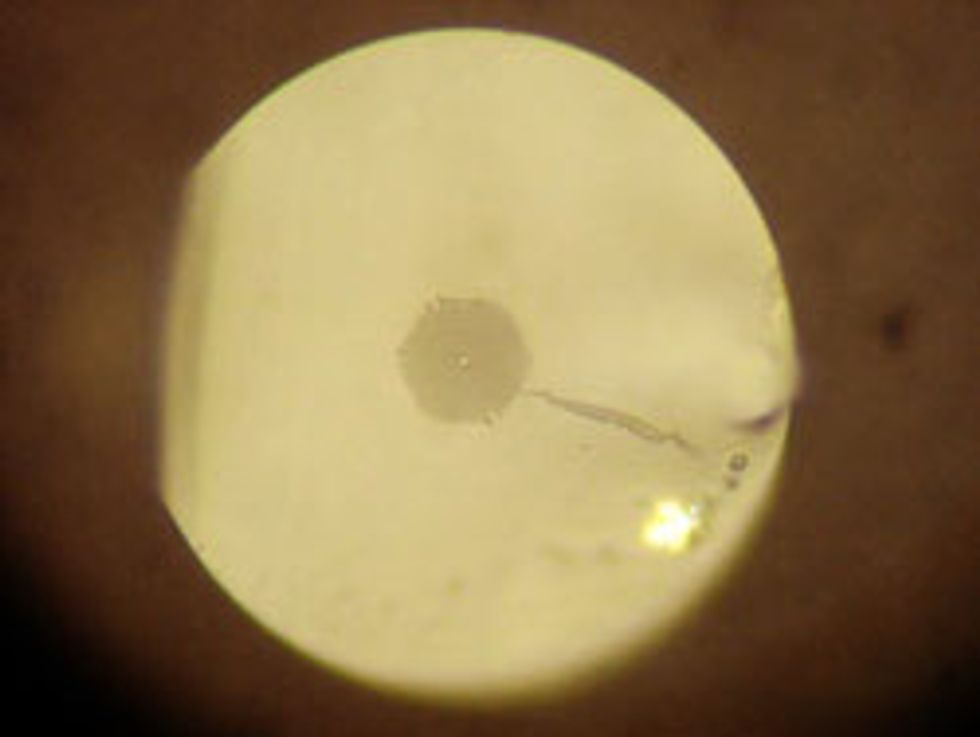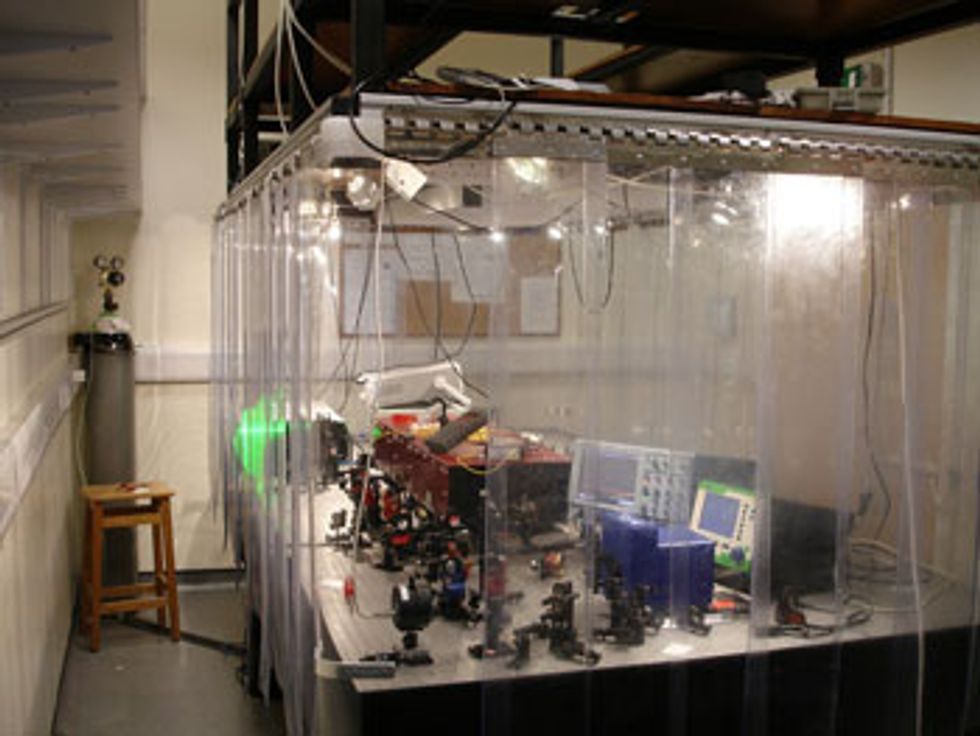7 March 2008—Physicists at the University of St. Andrews, in Scotland, report that they have created an analogue to a black hole in their lab. Such a tabletop black hole, made from a length of optical fiber and laser light, may prove invaluable in understanding the characteristics of these exotic astronomical objects, scientists say.
”About three and a half years ago, in August of 2004, I realized that it is possible to use optical fibers to create an analogue of a black hole,” says Ulf Leonhardt, who reported the research today in the journal Science . ”It took us a while to do the experiment because it was very hard to get funding.”
Leonhardt’s work is being feted by photonics experts, such as Ian Walmsley at Oxford University, as ”breaking new ground” in the field of nonlinear optics.
Black holes are some of the most exotic objects in the universe. They are incredibly dense, with powerful gravitational fields. One of the key characteristics of a black hole is its event horizon—a boundary that demarcates the region inside the black hole where the gravitational field is so intense that nothing, not even light, can escape.
Physicists and astronomers believe that black holes are formed when huge stars collapse in on themselves at the end of their lives. They exist at the centers of galaxies, where they act as giant engines that drive the motion of stars, according to astronomers. However, studying them is extremely difficult, particularly because in astronomy one can study only the information carried by light. In the case of black holes, the absence of light means astrophysicists have to rely on indirect means, such as inferring the presence of black holes by the way their gravity bends light outside their event horizons—a phenomenon scientists call gravitational lensing.
Having access to an artificial black hole in the lab will allow astrophysicists to test predictions made by theorists. Physicists would particularly like to test new theories such as quantum gravity, which seeks to reconcile Einstein’s theory of general relativity with quantum mechanics.
”It is much easier to use these objects for observations instead of their astronomical counterparts,” says Grigori Volovik of Helsinki University of Technology, in Finland, who has found other analogues of cosmological phenomena in laboratory condensed-matter physics.
Honeycomb Holes
A hexagonal array of holes runs the length of the fiber giving it properties that let scientists create an artificial event horizon.
To make their event horizon, Leonhardt and colleagues used a titanium sapphire laser and a microstructured optical fiber—one containing a hexagonal arrangement of air-filled holes that ran its length. They first transmitted an ultrashort, intense laser pulse down the optical fiber. The optical fiber is susceptible to nonlinear effects, such that when an intense pulse of light hits the fiber, it changes the physical properties of the fiber. In this case, the first pulse created a distortion that amounted to a change in the fiber’s index of refraction, which moves along with the pulse. The pulse itself was slowed by the distortion. Leonhardt and colleagues then sent a ”faster” stream of infrared laser light in pursuit of the first pulse. When the faster-moving second pulse encountered the distortion, it got trapped at its edge and couldn’t break past it. This edge became the fiber’s ”event horizon.”
”Light propagating in a moving medium is similar to the light propagating in curved space” such as you would find near a black hole, explains Volovik. So ”it is possible to create artificial horizons.”
Following Einstein’s theory of relativity, as light approaches the event horizon, it would slow down immensely and be stretched out; time would also proceed very slowly. Scientists have worked out what this deceleration would look like, and Leonhardt and colleagues say they observed the predicted effects in their optical-fiber event horizon.
Leonhardt and his colleagues hope their artificial event horizon will let experimentalists see whether anything can escape from a black hole. This highly counterintuitive idea was proposed by Stephen Hawking in the 1970s. Hawking applied tenets of quantum mechanics to existing black-hole theory and surmised that black holes are not black at all. Instead, they emit light—which has since come to be known as Hawking radiation.
The next step
A new laser experiment will test for signs of Hawking radiation from the fiber's event horizon.
Hawking radiation is possible because of the Heisenberg uncertainty principle in quantum mechanics, which maintains that you cannot pin down all the physical properties of a particle without any uncertainty. When it comes to a vacuum—empty space—this leads to a startling idea: a vacuum is not a vacuum at all but rather teeming with virtual particles and their antiparticles, which exist for a fraction of a second before coming together and annihilating one another. It seems nature doesn’t mind at all, as long as the particles exist for an amount of time less than the uncertainty level allowed by Heisenberg’s uncertainty principle.
In the highly unusual area around a black hole’s event horizon, however, things occasionally go wrong, and a virtual particle or antiparticle falls below the event horizon and cannot escape to recombine with its counterpart. The other virtual particle is forced to live longer than the uncertainty principle allows, in effect becoming a real particle. Enough of this happens near a black hole’s event horizon, Hawking postulated, that a black hole is not completely black but glows instead.
However, Hawking radiation is too weak to measure using telescopes because it is drowned out by the cosmic microwave background—the dim remnant radiation from the Big Bang that created the universe.
”These analogues are the best hope we have of testing the assumptions behind Hawking’s predictions of black-hole thermal radiation,” says William Unruh, a theoretical physicist at the University of British Columbia who is credited with pioneering the idea of using a moving medium as an analogue of the event horizon. ”Leonhardt’s work is definitely a promising step along the road, and it would be wonderful if such quantum thermal radiation from a black hole could be realized.”
That is indeed what the team at St. Andrews is trying to do. ”The next step is to try to measure the quantum effects,” Leonhardt says. ”We’ve started already.”
About the Author
Saswato R. Das is a writer based in New York City. He recently wrote about a new extreme ultraviolet laser and military experiments in the Van Allen belts.
Saswato R. Das writes about science and technology and is a spokesman for Lucent Technologies' Bell Labs in Murray Hill, N.J. His background is in physics.




